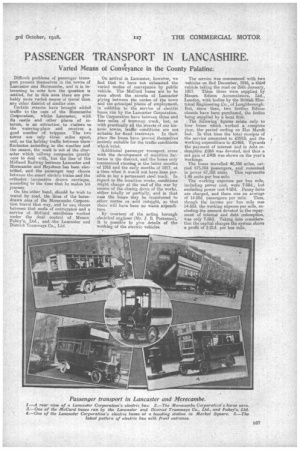PASSENGER TRANSPORT IN LANCASHIRE.
Page 17

If you've noticed an error in this article please click here to report it so we can fix it.
Varied Means of Conveyance in the County Palatine:
Difficult problems of passenger transport present themselves in the towns of Lancaster and Morecambe, and it is interesting to note how the question is settled, for in this area there are probably more varied means of travel than any other district of similar size. .
Certain reasons have brought added traffic to the cars of the Morecambe Coriporation, vsbilst Lancaster, with Its castle and other places of interest, is an attraction to visitors • to the watering-place and receives a good number of trippers. The two towns are only three miles apart, and, as the holiday traffic between them fluctuates according to the weather and the season the work is not of the character which railway companies greatly care to deal with, but the line of the Midland Railway between Lancaster and Morecambe and Heysham has been electrified, and the passenger may choose between the smart electric trains and the orthodox locomotive drawn carriages, according to the time that he snakes his journey.
On the Other band, iffiould he wish to travel by road, the lines of the horsedrawn cars of the .Morecambe Corporation travel that way, and he cans choose between that mode of conveyance and a service of McCurd omnibases worked under the dual control of Messrs. Fahey's, Ltd., and the Lancaster and District Tramways Co., Ltd. On arrival in Lancaster, however, we find that we have not exhausted the varied modes of conveyance by public vehicle. The MeCurd buses are to be seen about the streets of Lancaster plying between the centre of the town and the principal place.s of employment, in addition to the service of electric buses rtm by the Lancaster Corporation. The Corporation have between three and four miles of tramway track, but, as with practically all the streets of our historic towns, traffic conditions are not suitable for fixed tramways. In their place the buses have proved themselves entirely suitable for the traffic conditions which exist.
Additional passenger transport arose with the development of munition factories in the district, and the busies only commenced running in the -latter months of 1916 and the early months of 1917, at a time when it would not have been possible to lay a permanent steel track. In regard to the munition winks, conditions might change at, the end of the war by reason of the closing down of the works, either totally or partially, and in that case the buses may be transferred to .other routes or sold outeight, BO that there will have been no waste expenditure.
By courtesy of the acting borough electrical engineer (Mr. J. B. Patterson), it is possible to give details of the working of the electric vehicles.
The service was commenced with two vehicles on 2nd December, 1916, a third vehicle taking the road on 29th January, 1917. Thlase three were supplied by Messrs. Edison Accumulators, Ltd., London, with bodies by the British Electrical Engineering Co., of Loughborough. But, since then, two further Edison chassis have been -purchased, the bodies being supplied by a local firm. The following figures relate only to four buses which worked a complete year, the period ending on 31st March last. In that time the total receipts of the service amounted to S.:2815, and the working expenditure to 21464. Towards the payment of interest and in del-A redemption £864 was devoted, and thus a net gain of 486 was shown on the year's workings.
The buses travelled 46,358 miles, carried 675,504 passengers, and consumed in power 67,185 units. This represents 1.45 units per bus mile.
The working expenses per bus mite, including power cost, were 7-584., but excluding power coat 4-93d. Penny fares are charged, and there was an average of 14-58d. passeagers per mile. Thus, though the income per bus mile was 14-58d. the working expense per mile, excluding the amount devoted to the repayment of interest and debt redemption, was only 7-58d. Taking into consideration the capital charges the system shows a profit of 2-2Id. per bus mile.






















